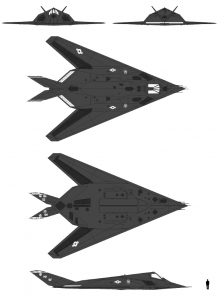Written by Jenifer Chrisman on January 28, 2019.
“Congratulations. You got the Black Jet you asked for. Learn to be comfortable with the night.”
– “The Porch” Personnel (early 1998)

Appearing more like something from a sci-fi movie, the Lockheed F-117 Nighthawk was the first U.S. top-secret stealth technology warplane. And despite its “F” (“Fighter”) designation, it had no aircraft-to-aircraft engagement capability; it was a ground-attack plane only.
Slightly slower than a B-52 Bomber, with a maximum speed of 623 miles per hour, the F-117s could fly 1,070 miles before refueling. This meant it often relied on aerial refueling, a rather difficult to accomplish feat at night with a stealth craft.

Kept private for the first five years of service, until the Pentagon released grainy photos, the F-117s strange and sinister appearance was designed around a promising new technology’s imposed limitations. The original research, attributed to Russian researcher Pyotr Ufimtsey in his 1964 paper, detailed that radar visibility was not only based on the size of an object, but also on the angle its waves reflect off edges. He showed this by a method he developed for calculating the visibility of the radar-cross section of objects.
In the late 1970s, Lockheed Martin, who had become interested in Ufimtsev’s research, began work on the Have Blue project. They employed flat surfaces to reflect radar waves away from the transmitter to design a plane with the smallest radar cross section to date.
In 1977, Lockheed rolled out the first two prototypes. Like no other aircraft, before or since, it was distinguished by its faceted 2-dimensional design. While later designs featured curved surfaces, these angular aircrafts were aerodynamically unstable due to the constraints of their design.
Due to this instability, the prototypes were nicknamed the “Wobbly Goblins” and required quadruple-redundant fly-by-wire controls and sophisticated flight computers to keep them stable. Both crashed in the test process but the Air Force, encouraged by their ability to evade radar detection, gave the go ahead and the new F-117 went into production.
Limited to just two bombs, generally 2,000 pounds and laser-guided, the F-117 used inertial navigation systems and GPS, as well as a thermal imager for targeting, as it lacked its own radar. It was painted black to reduce eye visibility, so it was flown exclusively at night. And it featured numerous designs now standard in stealth aircraft, including the use of radar-absorbent iron-ball paint, which was magnetically charged to reduce the reflection of electromagnetic waves; slit-shaped exhaust ports to minimize infrared exhaust signature and retractable communication antennas to reduce radar signature.
In 1981, the F-117A rolled off the line. It was the first of 64 built through 1990 at a cost of $111 million per plane. The production model’s handling was reported as more forgiving than the original prototypes.
The F-117 finally saw action as part of Operation Just Cause in Panama. But it wasn’t until the Gulf War that the F-117’s potential finally came to fruition when they launched some of the opening shots of the war in Bagdad on January 17, 1991. Throughout the course of the war the F-117s struck around 1,600 targets and flew approximately 1,280 missions.
The F-117s again saw action during the 1999 Kosovo War, dropping specialized BLU-114B graphite “soft bombs.” They also were involved in Operation Enduring Freedom and returned to Iraq in 2003.
After twenty-five years of operational service, the Lockheed F-117 Nighthawk was officially retired in August 2008. Although Lockheed later tried to market a more powerful and versatile variant, neither the U.S. Navy nor the Royal Air Force were interested.
Sources:



